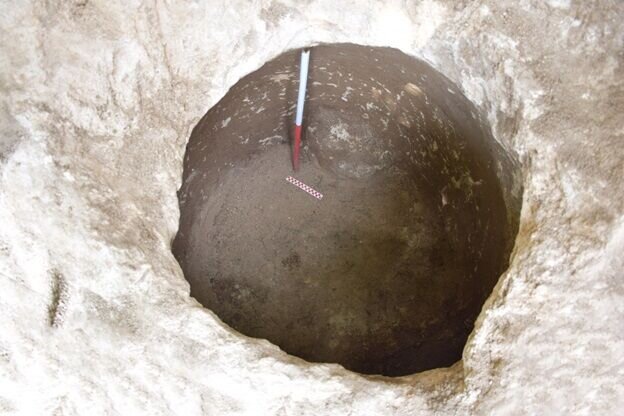Prehistorical grain storage discovered in northern Iran

TEHRAN – Locals have discovered a prehistorical grain storage pit during a construction operation being held in the northern village of Shamam in Gilan province.
“Part of a hand-made structure was recently found by chance during the construction of a residential building in Shamam village,” IRNA quoted Iranian archaeologist Solmaz Rauf as saying on Sunday.
“With the provincial cultural heritage experts present, the work was stopped and the manmade structure was documented and surveyed,” she added.
The discovery, which has an entrance diameter of 70 centimeters and a depth of 122 centimeters, is thought to be underground grain storage, she explained.
Such pits were mainly dug in fields with densely textured soil and are found in a variety of places and cultures, especially in moist areas, she noted.
Besides protecting their contents from insects and microorganisms, as well as mice and rodents, the storage pits provided a secure place to hide grain, which was the staple food in the past, from strangers and enemies, she added.
The official, however, did not provide further detail about the age of the underground storage.
Early people needed a sustainable way to store grain for use over long winters. Food preservation allowed communities to stay in one place, establishing towns and cities without the need to travel for food or better conditions. Some of the earliest forms of grain storage utilized baskets, sacks, and jars. Some communities had a separate storehouse where they kept grain inside in a large pile. In some societies, these storehouses may have also acted as a sort of social gathering place for hunter-gatherers.
Of course, these methods weren’t sustainable — jars, sacks, and baskets are only suitable for short-term use and small portions of the grain. Open or exposed storehouses left the grain vulnerable to rats, bacteria, insects, moisture, and parasites.
Archaeological evidence suggests that very early forms of the silo existed nearly 11,000 years ago, years before crop domestication became widespread. Early people likely used them to fight against famine. They predominantly stored barley and wheat, and the silos had raised platforms and slight slopes for drainage and moisture protection.
Some others used the underground pits. In this process, grain was conserved to be used as animal feed rather than to feed humans. The pit was hermetically sealed, and because of the low temperature and low oxygen levels, there were few insects.
Gilan is well-known for its rich Iron Age cemeteries such as Marlik that have been excavated over the past century. It was once within the sphere of influence of the successive Achaemenian, Seleucid, Parthian, and Sassanid empires that ruled Iran until the 7th century CE. The subsequent Arab conquest of Iran led to the rise of many local dynasties, and Gilan acquired an independent status that continued until 1567.
Sophisticated Rasht, capital of Gilan province, has long been a weekend escape for residents of Tehran who are looking to sample the famous local cuisine and hoping for some pluvial action – it's the largest, and wettest town in the northern region. Gilan is divided into a coastal plain including the large delta of Sefid Rud and adjacent parts of the Alborz mountain range.
ABU/AFM

Leave a Comment